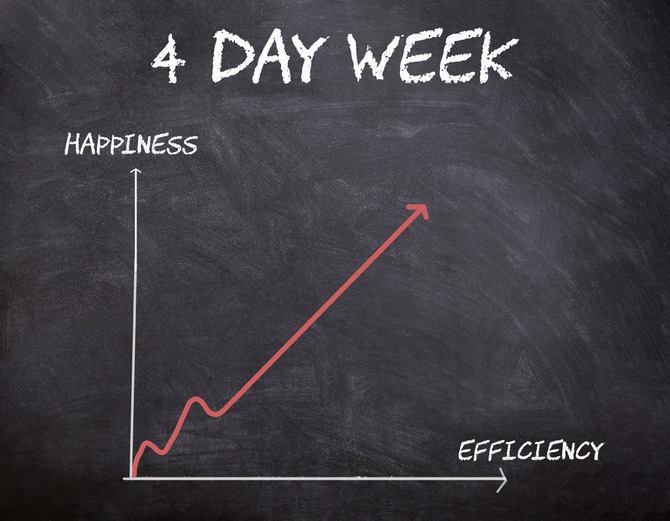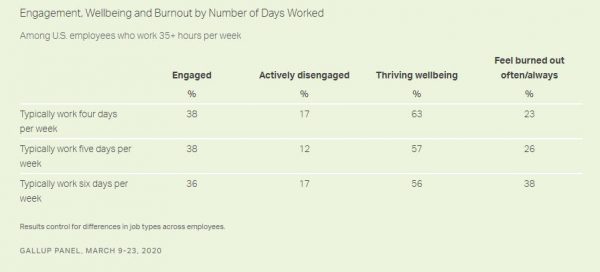Is a four-day workweek the answer to your engagement woes?
New Gallup research reveals that the issue’s not quite so simple. Read on for the pros and cons.

Graphic showing happiness increasing with efficiency during 4 days week. Employees and their time in employment. Question of productivity and efficiency
You’ve likely heard much ado about the slow but steady rise of the four-day workweek.
More companies are giving it a whirl, and many more around the world are seriously considering the measure as a way to counter pandemic-fueled burnout. Some experts even predict it’ll become a centerpiece of creating a thriving future workplace. But is a four-day workweek all it’s cracked up to be?
[RELATED: Join us Nov. 16 for our Bridging the Hybrid Divide Through Video Free Webinar]
While getting an extra day off per week sounds like a dream come true—and an easy way to win over exhausted workers—new Gallup research offers a bit of fascinating food for thought.
For starters, get a load of this chart:

See anything surprising here? Gallup explains:
“Interestingly, while the percentage of engaged workers was similar across the three work week conditions, the percentage of actively disengaged workers was highest for those with four-day and six-day work weeks. The ratio of engaged to actively disengaged employees was best for those with five-day work weeks — a ratio of 3.2-to-1.”
In other words, those working four days per week reported being just as actively disengaged as their six-day workweek counterparts. That’s likely to do with issues of isolation and lack of connectivity, but there’s certainly more going on. As Gallup explains, “By working fewer days per week, employees who already feel disconnected from their employer, team or manager are more likely to drift even farther away — from tolerating their jobs to hating them.”
However, this data highlights the notion that “engagement” and “well-being” are not at all synonymous.
Gallup writes:
“Gallup found wellbeing differences between those with four-day versus five-day work weeks. The percentage of full-time employees considered to be thriving was six percentage points higher for those in the four-day group. Burnout was three points lower for four-day workers—but active disengagement was five points higher.”
These particular findings indicate that a four-day workweek can slightly elevate well-being and reduce burnout, but not so much with boosting the prized notion of “engagement” that companies crave. Does this all mean the four-day workweek is fool’s gold? Well, that all depends.
Exploring the nuance
Ultimately, if employees hate their jobs and loathe the working conditions you’ve created, a four-day workweek won’t cure what ails them. Offering scheduling flexibility is a precious gift in any form, though you must dig deeper—and possibly get creative—to meet your employees’ primal longings for fulfilling work.
Consider this data:
- Gallup research has consistently found that workers want more flexibility—and that job flexibility is correlated with higher employee engagement. Work flexibility allows employees to boost their overall well-being in other areas while still meeting the requirements of their job. It also lowers stress by allowing people to create a schedule that makes sense for their life.
- Two-thirds or more of engaged employees are thriving in their overall lives regardless of days worked per week.
- An analysis of working populations in seven regions of the world found that for people with low job satisfaction and no opportunity to do what they do best, increasing hours worked led to declines in life evaluations and positive daily experiences. But the result was very different among employees with higher job satisfaction and an opportunity to play to their strengths and passions in their job. Positive daily experiences and life evaluation did not substantially deteriorate when hours worked per day increased from five hours to 10.
- When it comes to overall well-being, the quality of the work experience has 2.5 to three times the impact of number of days or hours worked.
The data seems to show that engagement is tied quality more so than quantity. At least in terms of time on the clock. As such, simply reducing the workweek by a day might not create the engagement boost you’d imagine—though it could lift employee well-being. The trick that companies must unlock is finding ways to scratch that itch we all have for meaningful work. Regardless of how many days per week you work.
If you want to try implementing a four-day workweek, here’s a framework to help you on your way.







